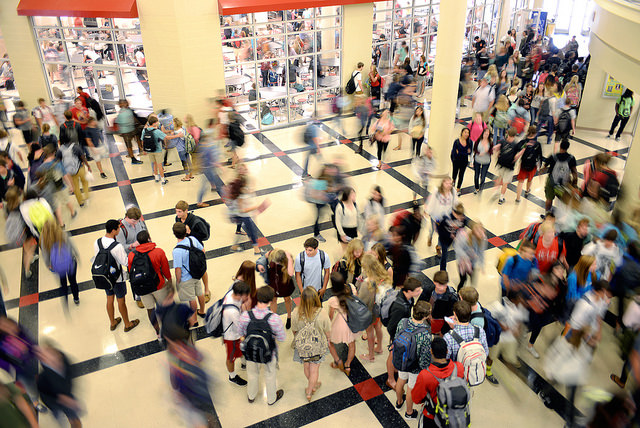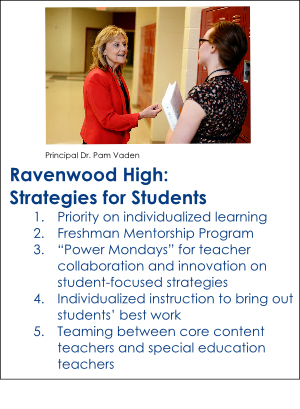Grady McGinnity, a senior at SCORE Prize finalist Ravenwood High School in Brentwood, wasn’t persuaded to take an advanced placement (AP) class by a teacher or guidance counselor. It was another student.
At the time, Grady was a freshman just learning to navigate his large new high school. An upperclassman connected with him through Ravenwood’s Freshman Mentorship Program (FMP). FMP sends mentors to each freshman homeroom on a regular basis. The visits are most concentrated at the beginning of each school year, when freshmen most need the relationship.
Mentors teach traditional pep rally cheers. They introduce the many diverse student organizations available at Ravenwood, which set a goal for every student to be involved in at least one student group or athletic team.  Details like the two-minute class warning bell are explained. Academic planning information and study tips are also shared, and when this information comes from a peer, the impact is outsized. Grady remembers the day a mentor calculated his grade point average (GPA) to demonstrate the importance of grades during the freshman year, and explained the weighting effect of AP classes. The mentor also discussed the benefits of AP exam credits.
Details like the two-minute class warning bell are explained. Academic planning information and study tips are also shared, and when this information comes from a peer, the impact is outsized. Grady remembers the day a mentor calculated his grade point average (GPA) to demonstrate the importance of grades during the freshman year, and explained the weighting effect of AP classes. The mentor also discussed the benefits of AP exam credits.
“I would not have taken the AP classes otherwise,” Grady said. “FMP is probably one of the biggest strengths of the school. It creates a very personalized feeling.”
With about 1,900 students in four grades and a 250,000-square-foot school building, there’s no question about it: Ravenwood is big. But that doesn’t mean students disappear into the crowd. With strategies like FMP and a teacher collaboration effort called Power Mondays, Ravenwood nurtures academic growth by creating an individualized experience for each student.
And students are succeeding at Ravenwood. The school has an AP pass rate of 79 percent, and a high ACT average of 24.5. Ravenwood students score well above statewide averages on all TCAP end of course assessments, and posted strong three-year marks on TVAAS growth in Algebra I and II, English II, and Biology I.
Ravenwood’s staff is intentional about forming relationships with students and quickly identifying those in need of additional supports. Special education and content teachers collaborate to meet all learning needs. A hallmark of classrooms throughout the school is student-focused – and often student-led – instruction. These practices are nourished by an innovation-friendly culture that encourages teachers to always find new ways to connect with each student.
Kristi Neuroth, a teacher of AP Human Geography at Ravenwood, says this culture begins at the county level. The superintendent of her school district, Williamson County Schools, sends a weekly email to teachers with reminders to recognize each individual student, to send positive notes home to families, and to always find new ways to reach out. And within Ravenwood, teachers have concrete opportunities to collaborate and push forward with “Power Mondays,” a weekly 40-minute block of time for teacher development and teamwork.
 “When teachers are treated like professionals and given creative space to dream big in their classrooms, I think that’s where the magic happens,” Ms. Neuroth said. “It’s a part of the culture to remind us not to get lost, to look for those things in each kid in our classroom. That comes from the top down and the bottom up.”
“When teachers are treated like professionals and given creative space to dream big in their classrooms, I think that’s where the magic happens,” Ms. Neuroth said. “It’s a part of the culture to remind us not to get lost, to look for those things in each kid in our classroom. That comes from the top down and the bottom up.”
Power Mondays began at Ravenwood in 2006 with a pilot so successful that the program is now in place at all middle and high schools in the district. Ravenwood Principal Pam Vaden said she keeps her requirements for Power Mondays simple. Teachers meet in small, same-subject teams and are asked to look at student data and determine which kids have grasped the material and need more enriching activities and which kids need additional help. Teachers are also asked to come up with a common assessment for every teacher on the Power Monday team to administer to students every 2½ weeks, and to analyze the results together. Beyond that, teachers are given freedom to use the time as they need.
“It’s such a part of our culture,” said Dr. Vaden. “We get those teachers together and just require a few things. They know where they need to go. You don’t have to tell them.”
Teacher collaboration has helped develop individualized instruction techniques used at Ravenwood. For example, Ms. Neuroth worked with another Ravenwood instructor to devise an “interactive notebook” strategy that has since been shared with educators across the county. Students take notes on a class discussion on the right side of a notebook, and personally reflect on the material on the left side. Responses have ranged from artistic and creative to quantitative and analytical. Students are able to approach the material from the angle most meaningful to them, without teachers attempting to design a class full of different assignments.
“A student is much more willing to work through the hard days if they know a teacher cares about them beyond the four walls of their classroom,” Ms. Neuroth said. “AP classes can be a huge leap from what they’ve done before. If they see you care about them and what they’re doing, they’re willing to do just about anything for you. No one wants to feel like a number when they go to school, ever.”
Learn more in this SCORE Prize video shot at Ravenwood.
